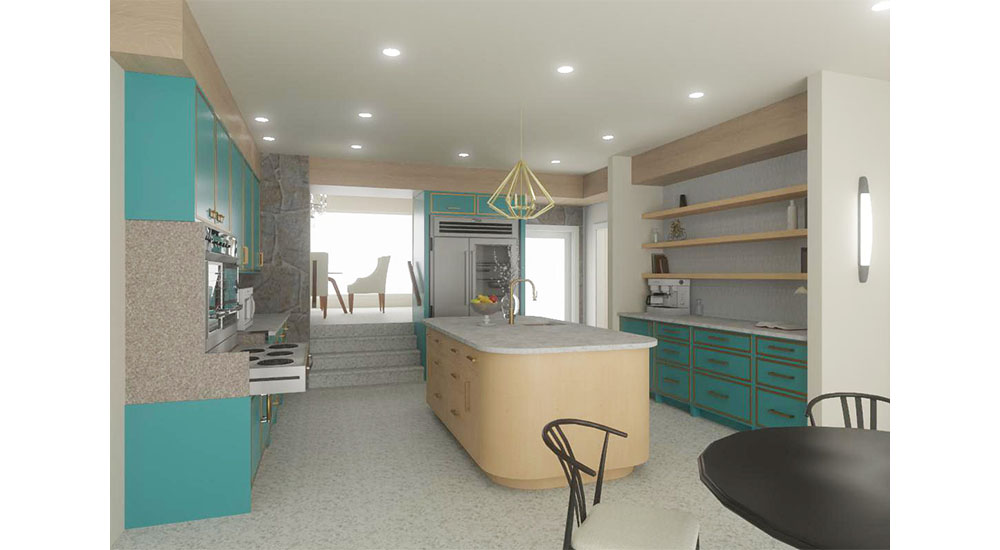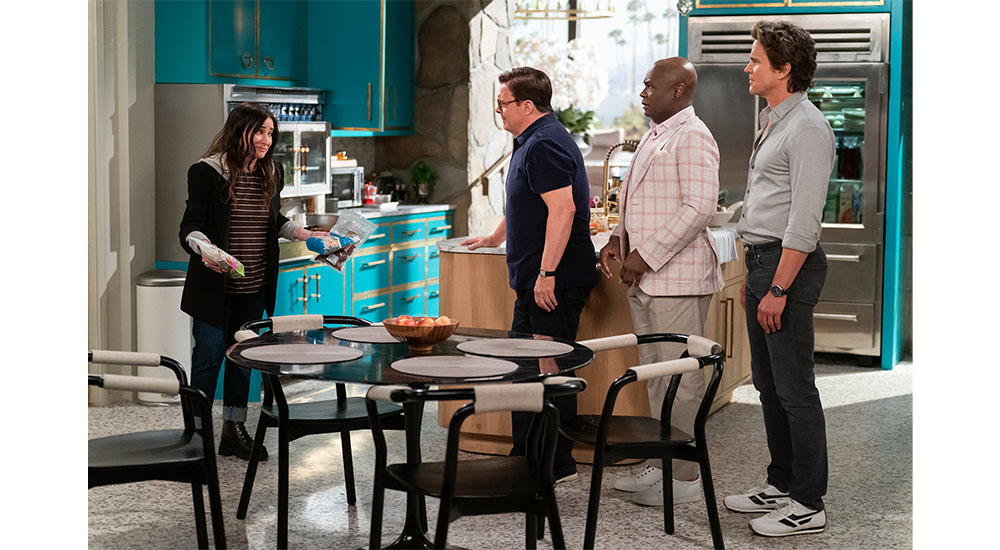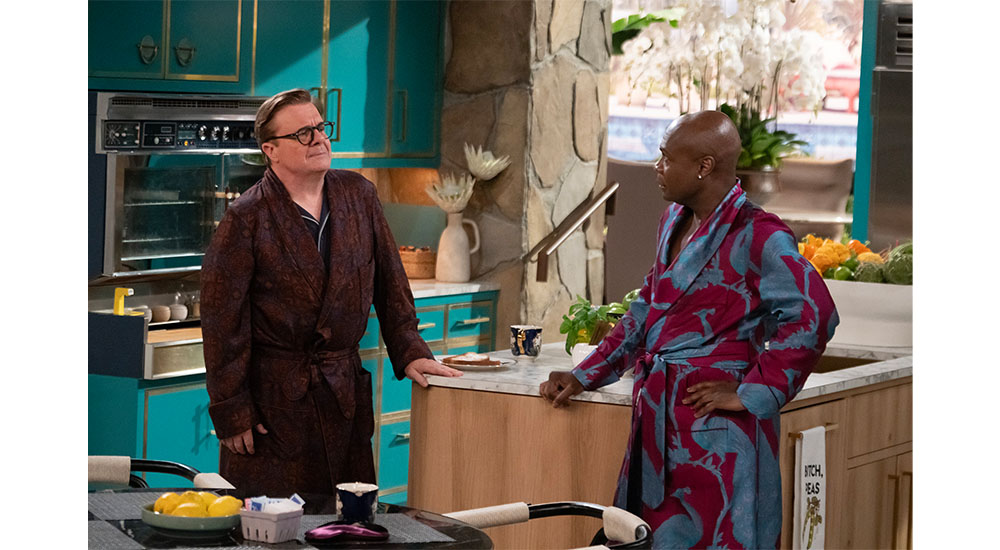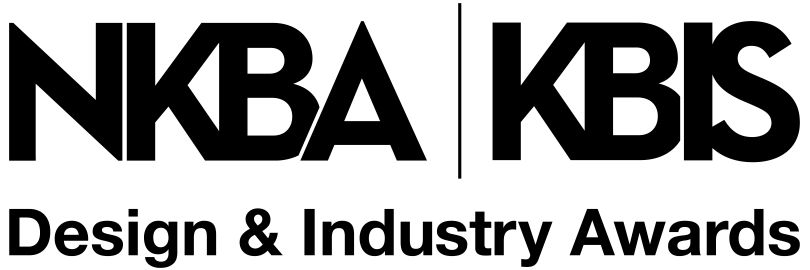Any kitchen you design should help your client tell the ongoing story of their life. That’s the insight I got from Peter Gurski, an interior designer whose kitchens have been enjoyed by millions of people. As a TV show set decorator with more than two dozen credits since 1996, including “Will & Grace” and “The New Adventures of Old Christine”, Gurski knows a thing or two about creating memorable residential spaces meticulously designed to help tell the stories of their inhabitants.
Some of his latest designs are featured in “Mid-Century Modern”, a Hulu show starring Nathan Lane. The series is classic network TV multi-cam fare, shot in front of a live studio audience. Hilarity ensues as three best friends live their golden years together in the design mecca of Palm Springs. They spend most of their time trading witty repartee in the show’s namesake-inspired kitchen, shown above.
Words, Then Vision
“Everything begins with the words on the page,” Gurski says. “You really have to service that character because it’s all about the story telling.”
Your client’s background stories – their goals, challenges and unique proclivities – are right there in your consultation meetings notes, perhaps driven by templated questions you ask for each kind of space your company designs and builds. What does success look like? Just imagine them living in the finished space, being happy and living life fully, with all their space-related needs being met. Who they really are emerges.
“I think the important thing is always to come back to the script and the story, because that is what really guides,” Gurski emphasizes. “It’s the same thing in film and television – we have to believe in the design, and then the audience and the client will follow.”
Listen and Edit

In this rendering of the “Mid-Century Modern” kitchen, you can see set decorator Peter Gurski’s approach to mixing eras and creating contrast. Vintage elements like the Flair-style oven with its unique pull-out burners stand alongside modern additions, such as a Sub-Zero fridge/freezer. Bold, metal-trimmed turquoise cabinets bring vibrant energy, beautifully balanced by the subdued, light wood island with its elegant curved corners. The open shelving further contributes to the kitchen’s airy feel, creating a lively yet inviting setting central to the show’s action. Computer drawing by Robert Anderson, Drury Design Chicago
Ever feel overwhelmed by the wishes of your client, your client’s spouse and maybe even your client’s parents? Once you’ve gathered all the input and ideas directly squarely at you, your job is to put it all together and edit out the things that aren’t as important considering the main goals and the budget.
Gurski’s plight for his TV kitchens, living rooms and bathrooms is similar, although magnified by collective directives of the studio executives, producers, the art director, the production designer, scriptwriters, and more.
“Because really, clients ask for the world,” he says. “But sometimes they don’t have the budget to back it up. So, you can be very gentle in editing … if you don’t feel like something is a great idea design-wise.”
Location, Location, Location
“In any sitcom, you’re either on the couch or in the kitchen,” Gurski shares, emphasizing the importance of thinking through the needs and nuances of the spaces where your clients spend most of their waking hours.
For client Bunny Schneiderman (Lane’s character), a fabulous personality of means who is getting used to retirement, Gurski knew each episode’s events would revolve around the kitchen – a gorgeous, carefully appointed stunner of a cooking and gathering space that lives up to the show’s setting in mid-century modern-obsessed Palm Springs.
Inspired by the actual Dinah Shore home, a famous mid-mod property designed by renowned architect Donald Wexler in 1964 (and currently owned by Leo DiCaprio), Gurski followed the rules. In-the-know designers understand that Palm Springers want two things in their updated mid-mod homes: a mix of vintage and new elements, and art-worthy design choices.
The kitchen balances a new 48” Sub-Zero glass door fridge/freezer (PRO4850G) with a vintage “Flair-style” range (pull-out burners below, hutch-style oven up above). A tulip table with minimally framed chairs keeps the foreground furniture from dominating the space. The viewer’s eye easily goes to the island’s light-stained base with rounded corners and then the vibrant turquoise cabinets with gold hardware.
Are the cabinets John Michael Studio Signature, modern-day St. Charles or your basic Hollywood custom prop shop creations? Gurski didn’t reveal all of the set’s secrets but he did tip his cap to Liz’s Antique Hardware, a go-to L.A. retailer for vintage and contemporary hardware.
Art-wise, set decorators need an artist’s permission to use a real or reproduced piece of art in a TV series, which can complicate things like filling the show’s gallery wall. Gurski has access to Hollywood art rental places that pre-clear art for studios, but says he likes to go out and find real art and talk to the artists themselves about rights. While show planning, he commonly visits Artwalk events at the Brewery Artist Complex, an L.A. artists-in-residence colony.
The Business of Beautiful

“Mid-Century Modern” stars Nathan Lane as Bunny Schneiderman, Matt Bomer as Jerry Frank, Nathan Lee Graham as Arthur Broussard, Pamela Adlon as Mindy Schneiderman and Linda Lavin as Sybil Schneiderman, Bunny’s mother. Photo credit: Disney/Christopher Willard
Gurski is quick to tell you that Los Angeles shares Palm Springs’ distaste for designers who rely on new-new-new without exploring vintage-recycled-repurposed. It’s no coincidence that DiCaprio’s go-to design firm in L.A., Pierce & Ward, often speaks of their 80/20 sourcing tendencies – 80% vintage, repurposed or recycled and 20% new, custom or wholesale.
And, of course, Hollywood has always celebrated the art of stagecraft and ingenuity for pulling off great looks on a budget. Gurski borrowed a producer’s $20k Hermès Pippa bench for both the “Will & Grace” and “Mid-Century Modern” sets before replacing it out of fear for damaging it. His solution? A $129 Home Goods quasi-similar bench priced at a 10% discount, reupholstered with $700 of hide from a leather supplier.
He isn’t ashamed of going to Lowe’s for the sink and faucets on the “Mid-Century Modern” kitchen set. And get this – one of the fantastic sculptural Mid-Mod sconces on the wall that looks vintage chic is something he actually made from putting together five sconces from a typical retail store (Possini Euro Gateway 20 ½” High Coppered Arch).
As he tells it, this kind of ingenuity is a great way to win the trust of your client. That trust earns you capital for your project’s must-haves.
“We certainly have to bring things in on budget,” he says. “But sometimes if there’s something you absolutely, absolutely have to have … you have a meeting just like you would with a client.”
This strategic approach to budget allocation – knowing when to splurge and when to save – mirrors what successful kitchen designers do every day. The key is to be transparent about where you’re investing the money and why those investments matter for the overall story the space is helping the client tell.
Lead with Your Design Heart
Whether designing for a sitcom kitchen that millions will scrutinize or a real family’s gathering space, (Gurski has designed plenty of both) Gurski’s final piece of advice rings true: “Lead with your design heart, because it’s that belief in your design which is going to bring you success with your client.”
The technical aspects of kitchen design – the measurements, mechanics and materials – can all be mastered. But it’s that secret ingredient of knowing what design choices are right, what Gurski calls the “secret sauce,” that separates good designers from great, sought-after ones.
“Your belief in that design with your little design heart,” he says, “is really what’s going to always lead you in the right place.”
In the end, whether your client is a fictional character living in Palm Springs or a real family living in your firm’s area of influence, the fundamentals remain the same. Listen to their story, edit their wish list with wisdom, and trust your instincts about what will make their space truly work for the life they want to live. After all, we’re all just trying to give our clients a place where they can live their story.
—Gladys Schanstra, CMKBD, is owner and president of Drury Design, a kitchen and bath build and design firm in Chicagoland. She’s also the company’s creative director and an active project designer.









